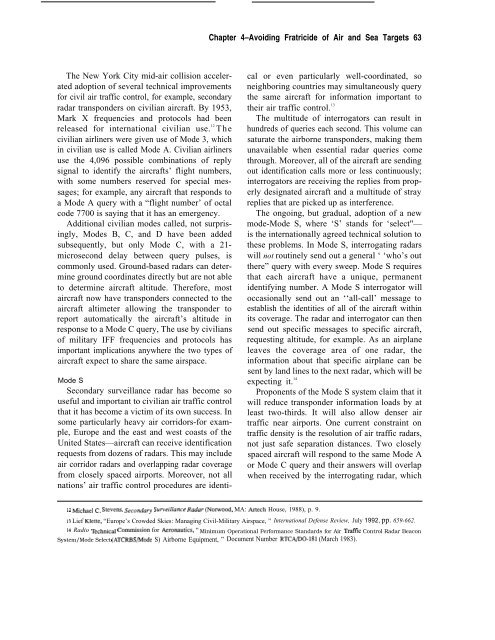Who Goes There: Friend or Foe? - Federation of American Scientists
Who Goes There: Friend or Foe? - Federation of American Scientists
Who Goes There: Friend or Foe? - Federation of American Scientists
Create successful ePaper yourself
Turn your PDF publications into a flip-book with our unique Google optimized e-Paper software.
The New Y<strong>or</strong>k City mid-air collision accelerated<br />
adoption <strong>of</strong> several technical improvements<br />
f<strong>or</strong> civil air traffic control, f<strong>or</strong> example, secondary<br />
radar transponders on civilian aircraft. By 1953,<br />
Mark X frequencies and protocols had been<br />
released f<strong>or</strong> international civilian use. 12<br />
The<br />
civilian airliners were given use <strong>of</strong> Mode 3, which<br />
in civilian use is called Mode A. Civilian airliners<br />
use the 4,096 possible combinations <strong>of</strong> reply<br />
signal to identify the aircrafts’ flight numbers,<br />
with some numbers reserved f<strong>or</strong> special messages;<br />
f<strong>or</strong> example, any aircraft that responds to<br />
a Mode A query with a “flight number’ <strong>of</strong> octal<br />
code 7700 is saying that it has an emergency.<br />
Additional civilian modes called, not surprisingly,<br />
Modes B, C, and D have been added<br />
subsequently, but only Mode C, with a 21microsecond<br />
delay between query pulses, is<br />
commonly used. Ground-based radars can determine<br />
ground co<strong>or</strong>dinates directly but are not able<br />
to determine aircraft altitude. <strong>There</strong>f<strong>or</strong>e, most<br />
aircraft now have transponders connected to the<br />
aircraft altimeter allowing the transponder to<br />
rep<strong>or</strong>t automatically the aircraft’s altitude in<br />
response to a Mode C query, The use by civilians<br />
<strong>of</strong> military IFF frequencies and protocols has<br />
imp<strong>or</strong>tant implications anywhere the two types <strong>of</strong><br />
aircraft expect to share the same airspace.<br />
Mode S<br />
Secondary surveillance radar has become so<br />
useful and imp<strong>or</strong>tant to civilian air traffic control<br />
that it has become a victim <strong>of</strong> its own success. In<br />
some particularly heavy air c<strong>or</strong>rid<strong>or</strong>s-f<strong>or</strong> example,<br />
Europe and the east and west coasts <strong>of</strong> the<br />
United States—aircraft can receive identification<br />
requests from dozens <strong>of</strong> radars. This may include<br />
air c<strong>or</strong>rid<strong>or</strong> radars and overlapping radar coverage<br />
from closely spaced airp<strong>or</strong>ts. M<strong>or</strong>eover, not all<br />
nations’ air traffic control procedures are identi-<br />
Chapter 4–Avoiding Fratricide <strong>of</strong> Air and Sea Targets 63<br />
12 Mi~lael c, Stevem, Se~o&~ Sumeillance R~ar @oWood, MA: fi~h House, 1988), p. 9.<br />
cal <strong>or</strong> even particularly well-co<strong>or</strong>dinated, so<br />
neighb<strong>or</strong>ing countries may simultaneously query<br />
the same aircraft f<strong>or</strong> inf<strong>or</strong>mation imp<strong>or</strong>tant to<br />
their air traffic control. 13<br />
The multitude <strong>of</strong> interrogat<strong>or</strong>s can result in<br />
hundreds <strong>of</strong> queries each second. This volume can<br />
saturate the airb<strong>or</strong>ne transponders, making them<br />
unavailable when essential radar queries come<br />
through. M<strong>or</strong>eover, all <strong>of</strong> the aircraft are sending<br />
out identification calls m<strong>or</strong>e <strong>or</strong> less continuously;<br />
interrogat<strong>or</strong>s are receiving the replies from properly<br />
designated aircraft and a multitude <strong>of</strong> stray<br />
replies that are picked up as interference.<br />
The ongoing, but gradual, adoption <strong>of</strong> a new<br />
mode-Mode S, where ‘S’ stands f<strong>or</strong> ‘select"—<br />
is the internationally agreed technical solution to<br />
these problems. In Mode S, interrogating radars<br />
will not routinely send out a general ‘ ‘who’s out<br />
there” query with every sweep. Mode S requires<br />
that each aircraft have a unique, permanent<br />
identifying number. A Mode S interrogat<strong>or</strong> will<br />
occasionally send out an ‘‘all-call’ message to<br />
establish the identities <strong>of</strong> all <strong>of</strong> the aircraft within<br />
its coverage. The radar and interrogat<strong>or</strong> can then<br />
send out specific messages to specific aircraft,<br />
requesting altitude, f<strong>or</strong> example. As an airplane<br />
leaves the coverage area <strong>of</strong> one radar, the<br />
inf<strong>or</strong>mation about that specific airplane can be<br />
sent by land lines to the next radar, which will be<br />
expecting it. 14<br />
Proponents <strong>of</strong> the Mode S system claim that it<br />
will reduce transponder inf<strong>or</strong>mation loads by at<br />
least two-thirds. It will also allow denser air<br />
traffic near airp<strong>or</strong>ts. One current constraint on<br />
traffic density is the resolution <strong>of</strong> air traffic radars,<br />
not just safe separation distances. Two closely<br />
spaced aircraft will respond to the same Mode A<br />
<strong>or</strong> Mode C query and their answers will overlap<br />
when received by the interrogating radar, which<br />
13 Lief IClette, “Europe’s Crowded Skies: Managing Civil-Military Airspace, ” International Defense Review, July 1992, pp. 659-662.<br />
14 Radio ~~~~~ Cotission f<strong>or</strong> Aeromutics, “ Minimum Operational Perf<strong>or</strong>mance Standards f<strong>or</strong> Air Trafilc Control Radar Beacon<br />
System/Mode Select (ATCRBS/Mode S) Airb<strong>or</strong>ne Equipment, ” Document Number RTCA/DO-181 (March 1983).
















